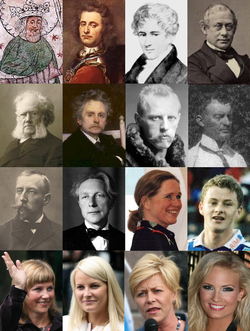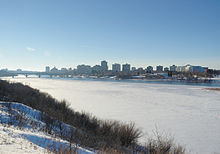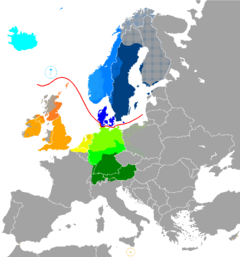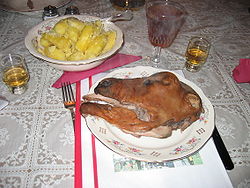- Norwegians
-
Norwegians
NordmennSt. Olaf • P. Tordenskjold • N. H. Abel • F. Stang
H. Ibsen • E. Grieg • F. Nansen • E. Munch
R. Amundsen • E. Groven • L. Ullmann • O. G. Solskjær
Pr. Märtha • Pr. Mette-Marit • S. Jensen • L-M. M. JüngeTotal population 12 milliona[citation needed]
(0.17% of the world's population) aRegions with significant populations  Norway[a]:4,305,886[1]
Norway[a]:4,305,886[1] United States
United States4,712,232 [2]  Canada[a]
Canada[a]521,390[3]  Brazil[a]
Brazil[a]465,441[4]  United Kingdom[a][b]
United Kingdom[a][b]13,798[5]
also circa 42,000 Orcadians and Shetlanders
 Sweden[a]
Sweden[a]48,385[6][7]  Australia
Australia32,850[8][9] Languages Norwegian
Closely related (mutually intelligible) languages include Danish and Swedish. Other related languages include Faroese and Icelandic, and to a lesser extent, all Germanic languages.
Norwegian Americans: Historically Norwegian, but later English because of Americanization.Religion Norse paganism (-900)
Catholic Christianity (1000-1500)
Lutheran Christianity(1600-)[10]Related ethnic groups Faroese, Icelanders, Germans/Austrians,[11] Danes, Dutch, Swedes, Shetlanders, Orcadians, Scots, English, Normans
Other Germanic ethnic groupsFootnotes a. ^ Does not include people of Faroese, Icelandic, Orcadian or Shetlandic ancestry. Does include persons with partial Norwegian ancestry. b. ^ Note that there are millions of Britons of Scandinavian ancestry and ethnicity, though mixed with others.
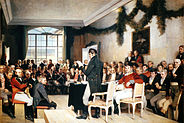
Part of a series on
Norwegians
Culture Architecture · Art · Cinema · Cuisine
Norwegian: nordmenn) constitute both a nation and an ethnic group native to Norway. They share a common culture and speak the Norwegian language. Norwegian people and their descendants are found in migrant communities worldwide, notably in United States, Canada and Brazil.Contents
History
Towards the end of the 3rd millennium BC, Proto-Indo-European speaking Battle-Axe peoples migrated to Norway bringing domesticated horses, agriculture, cattle and wheel technology to the region.
During the Viking age, Harald Fairhair unified the Norse petty kingdoms after being victorious at the The Battle of Hafrsfjord in the 880s. Two centuries of Viking expansion tapered off following the decline of Norse paganism with the adoption of Christianity in the 11th century. During The Black Death, approximately 60% of the population died and in 1397 Norway entered a union with Denmark.
In 1814, following Denmark-Norway's defeat in the Napoleonic Wars, Norway entered a union with Sweden and adopted a new constitution. Rising nationalism throughout the 19th century led to a 1905 referendum granting Norway independence. Although Norway remained officially neutral in World War I, the country was unofficially allied with the Entente powers. In World War II Norway proclaimed it's neutrality, but was nonetheless occupied for five years by Nazi Germany (1940–45). In 1949, neutrality was abandoned and Norway became a member of NATO. Discovery of oil and gas in adjacent waters in the late 1960s boosted Norway's economic fortunes but in referenda held in 1972 and 1994, Norway rejected joining the EU. Key domestic issues include integration of a fast growing immigrant population, maintaining the country's generous social safety net with an aging population, and preserving economic competitiveness.[12]
Geographic distribution
Main article: Norwegian diasporaAs with many of the people from European countries, Norwegians are spread throughout the world. There are more than 100,000 Norwegian citizens living abroad permanently, mostly in the U.S.A., U.K., and other Scandinavian countries.
Once one forgoes his or her Norwegian citizenship, he or she ceases to be Norwegian. Despite this, some people choose to continue see themselves as having ethnic or cultural ties to Norway; as such, they may include the word "Norwegian" in their description for themselves (for example, in the United States, Norwegian-Americans).
Viking Age
Norwegian Vikings travelled north and west and founded vibrant communities in the Faroe Islands, Shetland, Orkney, Iceland, Ireland, Scotland, and northern England[citation needed]. They conducted extensive raids in Ireland and founded the cities of Cork, Dublin, and Limerick[citation needed]. In 947, a new wave of Norwegian Vikings appeared in England when Erik Bloodaxe captured York.
Apart from Britain and Ireland, Norwegian Vikings established settlements in largely uninhabited regions[citation needed]. The first known permanent Norwegian settler in Iceland was Ingólfur Arnarson. In the year 874 he settled in Reykjavík.
After his expulsion from Iceland Erik the Red discovered Greenland, a name he chose in hope of attracting Icelandic settlers[citation needed]. Viking settlements were established in the sheltered fjords of the southern and western coast[citation needed]. Erik's relative Leif Eriksson later discovered North America.
The Netherlands
During the 17th and 18th centuries, many Norwegians emigrated to the Netherlands, particularly Amsterdam. This emigration is regarded as the second of the waves of emigration from Norway (the first being the trek to the England, Atlantic islands, Normandy, etc. during the Viking age, and the third was to North America, not counting the Gothic emigrations to Continental Europe in the 2nd and 3rd centuries A.D.). Loosely estimated, some 10% of the population may have emigrated, in a period when the entire Norwegian population consisted of some 800,000 people.
The Norwegians left with the Dutch trade ships that when in Norway traded for timber, hides, herring and stockfish (dried codfish). Young women took employment as maids in Amsterdam. Young men took employment as sailors. Large parts of the Dutch merchant fleet and navy came to consist of Norwegians and Danes. They took Dutch names, so no trace of Norwegian names can be found in the Dutch population of today. One well-known illustration is that of Admiral Kruys. He was hired in Amsterdam by Peter I to develop the Russian navy, but was originally from Stavanger, Norway (Kruys means "cross", and the Russian maritime flag is today also a blue cross on white background).
The emigration to the Netherlands was so devastating to the homelands that the Danish-Norwegian king issued penalties of death for emigration, but repeatedly had to issue amnesties for those willing to return, announced by posters in the streets of Amsterdam. Increasingly, Dutchmen who search their genealogical roots turn to Norway. Many Norwegians who emigrated to the Netherlands, and often were employed in the Dutch merchant fleet, emigrated further to the many Dutch colonies such as New Amsterdam (New York).
United States
Main articles: Norwegian American and Icelandic American A map of North America, with the percentage of Canada and Americans of Norwegian descent in each Canadian province and territory and U.S. state and Washington, D.C., respectively
A map of North America, with the percentage of Canada and Americans of Norwegian descent in each Canadian province and territory and U.S. state and Washington, D.C., respectively
Many Norwegians emigrated to the U.S.A. between the 1850s and the 1920s. Today, the descendants of these people are known as Norwegian Americans. According to the 2000 U.S. Census, three million Americans consider Norwegian to be their sole or primary ancestry. It is estimated that as many as a further 1.5 million more are of partial Norwegian ancestry. Travelling to and through Canada and Canadian ports were of choice for Norwegian settlers immigrating to the United States. In 1850, the year after Great Britain repealed its restrictive Navigation Acts in Canada, more and more emigrating Norwegians sailed the shorter route to the Ville de Québec (Quebec City) in Canada, to make their way on to USA cities like Chicago, Milwaukee, and Green Bay by steamer. For example, in the 1850s, 28,640 arrived at Quebec, Canada, en route to the USA, and 8,351 at New York directly.
Norwegian Americans represent 2-3% of the non-Hispanic Euro-American population in the U.S. They mostly live in both the Upper Midwest and Pacific Northwest.
Canada
Main articles: Norwegian Canadian and Icelandic CanadianAs early as 1814, a party of Norwegians was brought to Canada to build a winter road from York Factory on Hudson Bay in northern Canada to the infant Red River settlement at the site of present-day Winnipeg, Manitoba, Canada. Norway House is one of the oldest trading posts and Native-Canadian missions in the Canadian West. Willard Ferdinand Wentzel served the North West Company of Canada in the Athabasca and Mackenzie regions and accompanied Sir John Franklin on his overland expedition in 1819–20 to the Canadian Arctic.
Norwegians immigrated to Canada in search of the Canadian Dream. This immigration lasted from the mid-1880s until 1930, although Norwegians were already working in Canada as early as 1814. It can be divided into three periods of roughly fifteen years each. In the first, to about 1900, thousands of Norwegians homesteaded on the Canadian prairies. In the second, from 1900 to 1914, there was a further heavy influx of Norwegians immigrating to Canada from the United States because of poor economic conditions in the USA, and 18,790 from Norway. In the third, from 1919 to 1930, 21,874 people came directly from Norway, with the peak year in 1927, when 5,103 Norwegians arrived, spurred by severe depression at home. They came with limited means, many leaving dole queues.
From 1825 to 1900 some 500,000 Norwegians landed at Ville du Quebec in Canada (and other Canadian ports) for travelling through Canada was the shortest corridor to the USA's central states. In spite of efforts by the Government of Canada to retain these immigrants for Canada, very few remained because of Canada's somewhat restrictive land policies at that time and negative stories being told about Canada from U.S. land agents deterring Norwegians from going to Canada. Not until the 1880s did Norwegians accept Canada as a land of opportunity. This was also true of the many Americans of Norwegian heritage who immigrated to Canada from the USA with "Canada Fever" seeking homesteads and new economic opportunities. By 1921 one-third of all Norwegians in Canada had been born in the USA.
These new Canadians became British subjects in Canada, and part of the British Empire. Canadian citizenship, as a status distinct from that of a British subject, was created on 1 January 1947, with Canada being the first Commonwealth country to create their own citizenship. Prior to that date, Canadians were British subjects and Canada's nationality law closely mirrored that of the United Kingdom. On 1 January 1947, Canadian citizenship was conferred on most British subjects connected with Canada. Unlike in the USA, Canada was part of the British Empire and most Norwegians would have become Canadians and British subjects at the same time.
According to the 2006 Canadian census, 432,515 Canadians reported Norwegian ancestry (Norwegian-Canadians). Norwegians make up 2% of the White Canadian population. However, the actual figure may be higher. It is important to note that because so many Norwegian women married men of other nationalities, and thus by census rules are not counted as having children of this ethnic origin, this tends to reduce the number in the statistics.
Australia
Main articles: Norwegian Australian and Norwegian New ZealanderWest Germanic languages Dutch (Low Franconian, West Germanic)Low German (West Germanic)Central German (High German, West Germanic)Upper German (High German, West Germanic)English (Anglo-Frisian, West Germanic)Frisian (Anglo-Frisian, West Germanic)North Germanic languagesEast ScandinavianWest ScandinavianLine dividing the North and West Germanic languagesMain article: Norwegian language
Dutch (Low Franconian, West Germanic)Low German (West Germanic)Central German (High German, West Germanic)Upper German (High German, West Germanic)English (Anglo-Frisian, West Germanic)Frisian (Anglo-Frisian, West Germanic)North Germanic languagesEast ScandinavianWest ScandinavianLine dividing the North and West Germanic languagesMain article: Norwegian languageAn organized European immigration to Australia was initiated in 1788. And most of the early emigrants were deported from the Britain.
There were people from the British Isles as completely dominated when emigration to Australia changed character from being deported, to be virtually voluntary. In David Copperfield Charles Dickens allows Mr. Micawber go to Australia as a result of economic problems, and it was a piece on the way representative. From the 1830s used by the British authorities planned export of surplus population, and over the years up to 1897 was 600,000 persons exported in whole or in part at public expense.
But when the gold rush began in Australia in 1851 flocked to the volunteers, and it has been said that as many as 5000 Norwegian-born was in the periods. Around 1860 there shall have been around 2500 Norwegians there. A good number of these had previously tried luck that gold miners in California, and many went also return to America. Gullgravere guess almost by definition, fortune seekers, and thus prepared to move around depending on your luck might smile, and there was little stability there.
Russia
Further information: Kola NorwegiansIn the 19th century a community known as the Kola Norwegians settled in the environs of the Russian city of Murmansk. They have suffered persecution under Joseph Stalin and after 1990 were offered a chance to get back to Norway. There are very few of them left there today.
Other
See also: Norwegian settlement in Iceland, Scandinavian migration to the United Kingdom, Norwegian Swedes, Norwegian South African, and Scandinavian BrazilianGenetics
According to recent genetic analysis, both mtDNA and Y chromosome polymorphisms showed a noticeable genetic affinity between the Norwegian population and other ethnic groups in Northern and Central Europe, particularly with the Germans. This is due to a history of at least a thousand years of large-scale migration both in and out of Norway.[11]
The Norwegian population is typical of the Northern European population with Haplogroup I1 being most common. Norwegians also show the characteristic R1a genes of the paternal ancestorship at 17.9%[13] to 30.8%.[14] Such large frequencies of R1a have been found only in East Europe and India.[15] R1b gene showing paternal descent is also widespread at 25.9%.[13] to 30.8%[14]
Language
Norwegian is a North Germanic language with approximately 5 million speakers, of whom most are located in Norway. There are also some speakers of Norwegian in Denmark, Sweden, Germany, Britain, Spain, Canada, and the United States, where the largest community of speakers exists, with 55,311 speakers as of 2000; approximately half of the speakers live in Minnesota (8,060), California (5,865), Washington (5,460), New York (4,200), and Wisconsin (3,520).[16]
As of 2006, in Canada, there are 7,710 Norwegian speakers, of whom 3,420 reside in British Columbia, 1,360 in Alberta, and 1,145 in Ontario.[17]
Culture
Main article: Culture of NorwayNorwegian culture is closely linked to the country's history and geography. The unique Norwegian farm culture, sustained to this day, has resulted not only from scarce resources and a harsh climate but also from ancient property laws. In the 18th century, it brought about a strong romantic nationalistic movement, which is still visible in the Norwegian language and media. In the 19th century, Norwegian culture blossomed as efforts continued to achieve an independent identity in the areas of literature, art and music.
Cuisine
Main article: Cuisine of NorwayNorway's culinary traditions show the influence of long seafaring and farming traditions with salmon (fresh and cured), herring (pickled or marinated), trout, codfish and other seafood balanced by cheeses, dairy products and excellent breads (predominantly dark/darker). Lefse is a common Norwegian potato flatbread, common around Christmas. For renowned Norwegian dishes, see lutefisk, smalahove, pinnekjøtt, Krotekaker and fårikål.[18]
Music
Main article: Music of NorwayAlong with the classical music of romantic composer Edvard Grieg and the modern music of Arne Nordheim, Norwegian black metal has become something of an export article in recent years.
Norway's classical performers include Leif Ove Andsnes, one of the world's more famous pianists, and Truls Mørk, an outstanding cellist.
The jazz scene in Norway is also thriving. Jan Garbarek, Mari Boine, Arild Andersen, and Bugge Wesseltoft are internationally recognised while Paal Nilssen-Love, Supersilent, Jaga Jazzist and Wibutee are becoming world-class artists of the younger generation.[19]
Norway has a strong folk music tradition which remains popular to this day.[20] Among the most prominent folk musicians are Hardanger fiddlers Andrea Een, Olav Jørgen Hegge, Vidar Lande and Annbjørg Lien, violinist Susanne Lundeng, and vocalists Agnes Buen Garnås, Kirsten Bråten Berg and Odd Nordstoga.[21]
Celebrations
Norwegians celebrate their national day on May 17, dedicated to the Constitution of Norway. Many people wear bunad (traditional costumes) and most participate in or watch the Norwegian Constitution Day parade that day, consisting mostly of children, through the cities and towns. The national romanticist author Henrik Wergeland was the founder of the 17 May parade. Common Christian holidays are also celebrated, the most important being Christmas (called Jul in Norway after the pagan and early Viking winter solstice) and Easter (Påske). In Norway, the Santa (called Nissen) comes at Christmas Eve, the 24th of December, with the presents, not the morning after as in many English speaking countries. He usually comes late in the evening, after the Christmas dinner many children consider long, boring and unnecessary.
Jonsok (St. John's Passing), or St. Hans (St. John's Day), i.e. 24 June, is also a commonly revered holiday. It marks midsummer and the beginning of summer vacation, and is often celebrated by lighting bonfires the evening before. In Northern areas of Norway, this day has 24 hours of light, while southern areas have only 17.5 hours.
Religion
 Our Savior's Lutheran Church, a Lutheran church located near Cranfills Gap, Texas in an unincorporated community known as Norse, Texas. The congregation for the church was organized on June 14, 1869 by Norwegian settlers of Bosque County, Texas.
Our Savior's Lutheran Church, a Lutheran church located near Cranfills Gap, Texas in an unincorporated community known as Norse, Texas. The congregation for the church was organized on June 14, 1869 by Norwegian settlers of Bosque County, Texas. See also: Religion in Norway and Norwegian American#The Norwegian Lutheran Church in the United States
See also: Religion in Norway and Norwegian American#The Norwegian Lutheran Church in the United StatesThe conversion of Norway to Christianity from Norse paganism began in 1000 AD. By the middle of the 11th century, Christianity had become well-established in Norway and had become dominant by the middle of the 12th century. The Norwegians were Catholics until the Danish king Christian III of Denmark forced them to convert to Lutheranism and established a state-governed church. The church undertook a program to convert the Sámi in the 16th and 17th century, with the program being largely successful.
In the 19th century, emigration from Norway for political and religious motives began and Lutheranism spread to the United States. As a result of this,[citation needed] many of the Norwegians remaining in Norway were religiously moderate; subsequently, church attendance declined throughout the 20th century, as reflected by 78% of the population stating that religious is unimportant in a Gallup poll[22] and low weekly church attendance, at 2%,[23] particularly when compared to that of North Dakota, the state in which Norwegians constitute approximately 30.4% of the population. Of all U.S. states, North Dakota has the lowest percentage of non-religious people and the largest number of churches per capita. It weekly church attendance is at 43%.[24][25][25][26]
In Norway the Church of Norway and state are not separated. When baptised, children are registered in the Church of Norway's member register, leading to a large membership, although many people do not remain observant as adults. A majority of both ethnic Norwegians and Sámi are nominally Christian, but not necessarily observant.
Famous Norwegians
This list only includes people of some notable Norwegian ancestry.
- Dominic Purcell, Australian actor famous from the popular TV-Series Prison Break.
- Eliot Ness, legendary American Prohibition Agent, notable for being the man who brought down gangster Al Capone.
- Geir Haarde, former prime minister of Iceland.
- Iggy Pop, American musician.
- John Ashcroft, US Attorney General.
- Joni Mitchell, Canadian singer.
- Josh Groban, American singer.
- Kjell Laugerud García, former dictator of Guatemala.
- Kristanna Loken, American actress.
- Marilyn Monroe, legendary American actress, model and singer.
- Matt Groening, creator of world famous TV-cartoon The Simpsons.
- Melyssa Ford, Canadian supermodel of Norwegian, Russian and Caribbean descent.
- Paris Hilton, American media personality, model, singer, and actress. Heiress of Hilton Hotels.
- Tom Waits, American singer.
- Russel Crowe, a New Zealand born Australian actor.
- Walter Mondale, former US Vice President and Senator.
- A-ha, Norwegian pop group
Other terms used
The Norwegians are and have been referred to by other terms as well. Some of them include:
- Nordmenn: A term used by Scandinavians to denote Norwegians. It translates as "Northmen". (Singular: Nordmann)
- Northmen: Old term used by other European peoples to denote the peoples originating in the northern regions of Europe.
- Norsemen or Norse: Viking Age peoples of Nordic origin.
- Vikings: Used in the Nordic countries to denote people who went raiding, pillaging or slave catching during the Viking Age. Used in a similar way by other peoples but can also mean Scandinavians in general.
- Minnewegian: Colloquial term for a Norwegian Minnesotan.
- Norrbagge: A Swedish derogatory term for Norwegians (first attested use in 1257), based on the root bagge meaning sheep's testicles.
- Norski: Common name for Northern American Norwegians.
See also
References
- ^ "Without immigrant background" : Population 1.1.2010 (4 305 886 [1])
- ^ The 2000 American census reports that the United States, in the 2000 census, has 4,477,725 inhabitants of (partial) Norwegian ancestry.
- ^ Shows a list over Canadas different ethnic groups, reports that there is 363,760 persons reporting Norwegian as one ancestry in Canada, of these 44,790 reported only Norwegian.
- ^ The 2000 Brazilian census reports that Brazil, in the 2000 census, has 465,44 inhabitants of (partial) Norwegian ancestry.
- ^ Number of Norwegians registered at the Embassy for living in each of these countries.
- ^ Swedish Statistics from 2005. Shows the official number of Norwegians in Sweden at page 20.
- ^ Sweden: Stock of foreign-born population by country of birth, by year
- ^ Swedish Statistics from 2005. Shows the official number of Norwegians in Sweden at page 20.
- ^ Australian: Stock of foreign-born population by country of birth, by year
- ^ 83% of the population of Norway are members of the Christian Evangelical Lutheran Church of Norway. Norway is highly secularized, and only about 10% of the population attend religious services more than once a month. The Norwegians in Norway are more secular than the Norwegians in the United States. North Dakota has the lowest percentage of non-religious people of any state, and it also has the most churches per capita of any state, which is a state were 30.4 % of the population is Norwegian.
- ^ a b http://hpgl.stanford.edu/publications/EJHG_2002_v10_521-529.pdf
- ^ https://www.cia.gov/library/publications/the-world-factbook/geos/no.html
- ^ a b http://www.ajhg.org/AJHG/abstract/S0002-9297(07)63256-X Estimating Scandinavian and Gaelic Ancestry in the Male Settlers of Iceland - Agnar Helgason et al., 2000, Am. J. Hum. Genet. 67:697–717, 2000
- ^ a b Rosser et al. (2000)
- ^ F. Luca, F. Di Giacomo, T. Benincasa et al., "Y-Chromosomal Variation in the Czech Republic," American Journal of Physical Anthropology 132:132–139 (2007).
- ^ U.S Census 2000
- ^ Detailed Mother Tongue (148), Single and Multiple Language Responses (3) and Sex (3) for the Population of Canada, Provinces, Territories, Census Metropolitan Areas and Census Agglomerations, 2006 Census – 20% Sample Data. 2007. http://www12.statcan.ca/census-recensement/2006/dp-pd/tbt/Rp-eng.cfm?TABID=1&LANG=E&APATH=3&DETAIL=0&DIM=0&FL=A&FREE=0&GC=0&GK=0&GRP=1&PID=89186&PRID=0&PTYPE=88971,97154&S=0&SHOWALL=0&SUB=0&Temporal=2006&THEME=70&VID=0&VNAMEE=&VNAMEF=.
- ^ Culture of Norway. Everyculture.com. Retrieved 27 November 2008.
- ^ Culture from Study in Norway. Retrieved 2 December 2008.
- ^ Norwegian Folk Music from Norway, official site in the UK. Retrieved 25 November 2008.
- ^ Contemporary art from Norway the official site. Retrieved 28 November 2008.
- ^ GALLUP WorldView
- ^ Stavanger Aftenblad - 2 prosent går i kirken på en vanlig søndag
- ^ "American Religious Identification Survey". Exhibit 15. The Graduate Center, City University of New York. http://www.gc.cuny.edu/faculty/research_briefs/aris/key_findings.htm. Retrieved 2006-11-24.
- ^ a b "North Dakota Movers". US-Moving.com. http://www.us-moving.com/north-dakota.html. Retrieved 2007-08-19.
- ^ San Diego Times, May 2, 2006, from 2006 Gallup survey
Norwegian diaspora Europe 
Africa Americas Asia & Oceania  Norway topics
Norway topicsHistory Geography Law Politics Constitution · Counties · Elections · European Union relations · Foreign relations · Government · Monarchy · Municipalities · Political parties · Prime Minister (List) · Romantic nationalism · Sámi Parliament · ParliamentEconomy Norwegian krone · National Bank · Oslo Stock Exchange · Education · Energy · Media · Tourism · Transport · Companies · WhalingMilitary Symbols Demographics Administrative divisions · Cities · Postal codes · Languages · Religion · Immigration · Norwegians · List of NorwegiansCulture Architecture · Art · Cinema (Actors) · Music (Composers) · Cuisine · Norwegian language · Literature (Writers · Poets) · Bunad · Jul · Constitution Day · Media · Football · Rugby union · Public holidaysCategories:- Norwegian diaspora
- Ethnic groups in Europe
- Ethnic groups in Norway
- Norwegian people
Wikimedia Foundation. 2010.
Look at other dictionaries:
Norwegians of Pakistani descent — Infobox Ethnic group group = Norwegians of Pakistani descent poptime = 29,134 legal residents 0.8% of the Norwegian population popplace = Oslo Bergen langs = Norwegian Urdu Languages of Pakistan rels = Islam Others related = Overseas… … Wikipedia
Norwegians with Pakistani background — Pakistani Norwegian Hadia Tajik Abid Raja … Wikipedia
Norwegians — Nor·we·gian || nÉ”Ë wiËdÊ’É™n n. language spoken in Norway adj. from Norway; of or relating to Norway n. native or resident of Norway … English contemporary dictionary
Kola Norwegians — The Kola Norwegians were Norwegian settlers along the coastline of the Kola Peninsula in Russia.In 1860 the Russian Tsar Alexander II granted permission for Norwegian settlements on the Kola. Around 1870, scores of families from Finnmark in… … Wikipedia
List of Norwegians — This is a list of notable people from Norway. Art Literature * Roald Dahl, British children s author of Norwegian descent. * Ingvar Ambjørnsen, author * Kjell Aukrust, author and illustrator * Olav Aukrust, poet * Ari Behn, author, and husband of … Wikipedia
Norway — /nawr way/, n. Norwegian, Norge. a kingdom in N Europe, in the W part of the Scandinavian Peninsula. 4,404,456; 124,555 sq. mi. (322,597 sq. km). Cap.: Oslo. * * * Norway Introduction Norway Background: Despite its neutrality, Norway was not able … Universalium
Norwegian people — Ethnic group group=Norwegians(Nordmenn) caption= Peder Tordenskjold • Niels H. Abel • Frederik Stang • Fridtjof Nansen Roald Amundsen • Eivind Groven • Liv Ullmann • Ari Behn poptime=10 to 12 million including ancestry (est.)… … Wikipedia
Norwegian American — Norskamerikanere … Wikipedia
Norway — For other uses, see Norway (disambiguation). Kingdom of Norway Kongeriket Norge (Bokmål) Kongeriket Noreg (Nynorsk) … Wikipedia
Union between Sweden and Norway — United Kingdoms of Sweden and Norway Förenade konungarikena Sverige och Norge De forenede Kongeriger Norge og Sverige Personal union ← … Wikipedia

